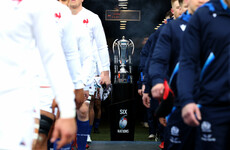MANY RUGBY FANS would say that the All Blacks have always had the edge over their opponents because of the calibre of players in their team.
However, their advantage starts even before the first whistle is blown.
Why? The haka – or in the world of neurophysiology, the ultimate ‘ON’ switch for the central nervous system (CNS).
The haka is a ceremonial Māori dance that would have historically been performed prior to battles but has been a regular sight on the rugby pitch through the All Blacks since the early 1900s.
Looking at the haka from a purely physical point of view, it involves loud shouting and rhythmic ‘punching’ of the four limbs and torso for approximately one minute.
The shouting/chanting during the haka requires forced expiration of air from the lungs. This means the following inhalation is deeper, resulting in greater oxygen intake.
That, in turn, means more oxygen is in the bloodstream and the maximal delivery of that oxygen to the cell mitochondria, which are essentially the cells’ fuel tanks.
And this is what the CNS loves, ensuring that every cell in the body is able to do its job so the brain doesn’t have to think of them.
For the next 80 minutes of the rugby game that flows, the CNS can then get on with what is demanded of it: increase the speed of nerve activity along motor/sensory nerves, increase nerve function – especially cranial nerves involved in vision, hearing and balance, and enhanced decision making.
These are all important for the chaos of pitch sports.
And banging the limbs? This stimulates the myofascial slings – the band of soft tissue that diagonally crosses the torso allowing for better force transmission/absorption within the skeleton.
This all occurs while the All Blacks’ opponents stand and watch.
So are other rugby teams suddenly going to unearth ancient war-cries to use in the same way? Not quite.
Activation techniques are being utilised by some athletes in certain sports.
At this year’s Champions League final, Gareth Bale stood on the sideline rubbing various CNS ‘hack’ points on his rib cage in order to stimulate better diaphragm function for the aforementioned increased oxygen benefit. We all know what the goal was like that he went onto score.
You might recall seeing 100m sprinters punching their butt at the race start line, stimulating their myofascial slings – another ‘ON’ switch.
In the world of professional sports, where marginal gains are so integral, CNS hacks are the next sphere to be harnessed.
Being ready is good. Being ready and ‘ON’ is better.
Orla Magorrian holds an M.Sc in Sports Medicine, is a member of the Irish Society of Chartered Physiotherapists, a Certified Strength and Conditioning Specialist, and BeActivated practitioner.
Subscribe to our new podcast, Heineken Rugby Weekly on The42, here:












Is he Welsh?
@Trevor Beacom: nope born in England to two Irish parents
Looking forward to John Cooney coming to Ulster. He could surprise a few people if he stays fit and if he gets game time. Paul Marshall really always has been an impact player. It will be interesting to see if he can gel with PJ and how well he can develop.